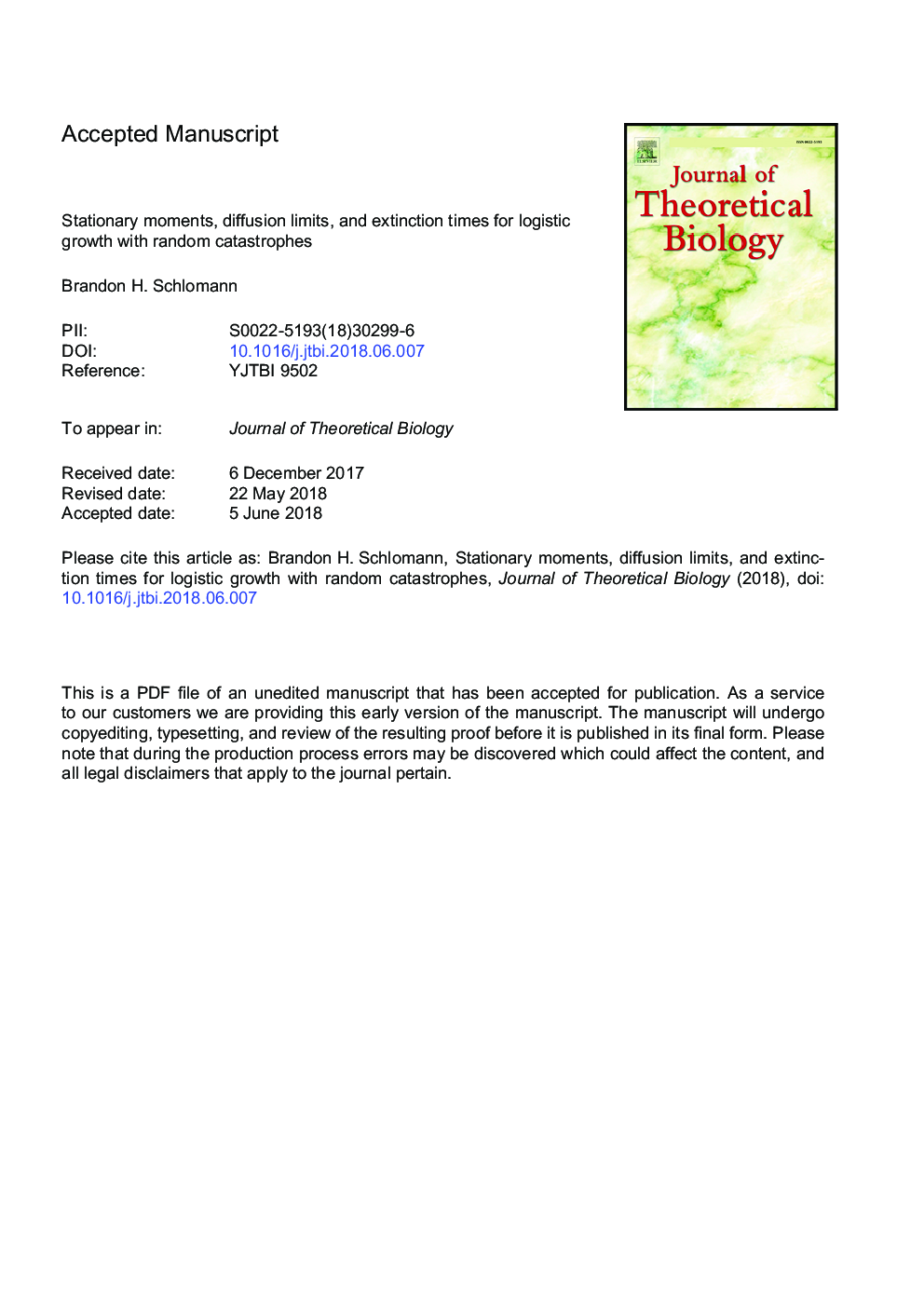| کد مقاله | کد نشریه | سال انتشار | مقاله انگلیسی | نسخه تمام متن |
|---|---|---|---|---|
| 8876556 | 1623756 | 2018 | 34 صفحه PDF | دانلود رایگان |
عنوان انگلیسی مقاله ISI
Stationary moments, diffusion limits, and extinction times for logistic growth with random catastrophes
ترجمه فارسی عنوان
لحظات ثابت، محدودیت انتشار و زمان انقراض برای رشد لجستیکی با فاجعه
دانلود مقاله + سفارش ترجمه
دانلود مقاله ISI انگلیسی
رایگان برای ایرانیان
کلمات کلیدی
دینامیک جمعیت تصادفی، فاجعه بار تصادفی تصدی محیط زیست، معادلات دیفرانسیل تصادفی،
ترجمه چکیده
یک مشکل مرکزی در اکولوژی جمعیت، درک پیامدهای نوسانات تصادفی است. مدل های قابل تحسین برانگیز با صدای رانندگی گاوسی منجر به بینش کلی و مهم می شوند، اما آنها نتوانستند رویدادهای نادر و فاجعه بار را که در بین مقیاس های بین شیلات جهانی و میکروبیولوژیست روده ای مشاهده می شوند، ترسیم کنند. با توجه به چالش های ریاضی، فاکتورهای رشد با فاجعه های تصادفی به خوبی مشخص نیست و هنوز مشخص نیست که چگونه عواقب آنها متفاوت از فرآیندهای گاوسی است. در مواجهه با تغییرات آب و هوایی و پیش بینی افزایش فاجعه زیست محیطی، و همچنین افزایش علاقه به استفاده از میکروب برای درمان، این فرآیندها هرگز بیشتر مربوط نیست. برای درک بهتر آنها، در اینجا یک مدل معادلات دیفرانسیل رشد لجستیک به همراه فاجعه ای مستقل با تراکم که به عنوان یک فرآیند پوآسون وارد می شود، بازبینی می شود و نتایج تحلیلی جدیدی را نشان می دهد که ساختار آماری آن را نشان می دهد. اولا من عبارات دقیق برای لحظات ثابت مدل را نشان میدهم، که یک پارامتر فاجعه بار موثر را نشان میدهد که عمدتا آمارهای مرتبه پایین را کنترل می کند. سپس، از قضیه همگرایی ضعیف برای ساخت آنالوگ گاوسی در حد فاجعه مکرر و کوچک، استفاده می کنم، ثابت نگه داشتن ثابت ثابت جمعیت برای عادی سازی. آمار محاسبات عددی در این محدودیت نشان می دهد که چگونه آنها به صورت پویایی تغییر می کنند از فاجعه به انتشار، و امکان مقایسه های کمی را فراهم می کند. به عنوان مثال، میانگین زمان انقراض به طور انحصاری بر حسب شدت افزایش می یابد و خطر انقراض را به شدت بالاتر از فاجعه افزایش می دهد. با هم، این نتایج بینش را به طیف گسترده ای از سیستم های دینامیکی تصدیق مهم برای بوم شناسی و حفاظت.
موضوعات مرتبط
علوم زیستی و بیوفناوری
علوم کشاورزی و بیولوژیک
علوم کشاورزی و بیولوژیک (عمومی)
چکیده انگلیسی
A central problem in population ecology is understanding the consequences of stochastic fluctuations. Analytically tractable models with Gaussian driving noise have led to important, general insights, but they fail to capture rare, catastrophic events, which are increasingly observed at scales ranging from global fisheries to intestinal microbiota. Due to mathematical challenges, growth processes with random catastrophes are less well characterized and it remains unclear how their consequences differ from those of Gaussian processes. In the face of a changing climate and predicted increases in ecological catastrophes, as well as increased interest in harnessing microbes for therapeutics, these processes have never been more relevant. To better understand them, I revisit here a differential equation model of logistic growth coupled to density-independent catastrophes that arrive as a Poisson process, and derive new analytic results that reveal its statistical structure. First, I derive exact expressions for the model's stationary moments, revealing a single effective catastrophe parameter that largely controls low order statistics. Then, I use weak convergence theorems to construct its Gaussian analog in a limit of frequent, small catastrophes, keeping the stationary population mean constant for normalization. Numerically computing statistics along this limit shows how they transform as the dynamics shifts from catastrophes to diffusions, enabling quantitative comparisons. For example, the mean time to extinction increases monotonically by orders of magnitude, demonstrating significantly higher extinction risk under catastrophes than under diffusions. Together, these results provide insight into a wide range of stochastic dynamical systems important for ecology and conservation.
ناشر
Database: Elsevier - ScienceDirect (ساینس دایرکت)
Journal: Journal of Theoretical Biology - Volume 454, 7 October 2018, Pages 154-163
Journal: Journal of Theoretical Biology - Volume 454, 7 October 2018, Pages 154-163
نویسندگان
Brandon H. Schlomann,
